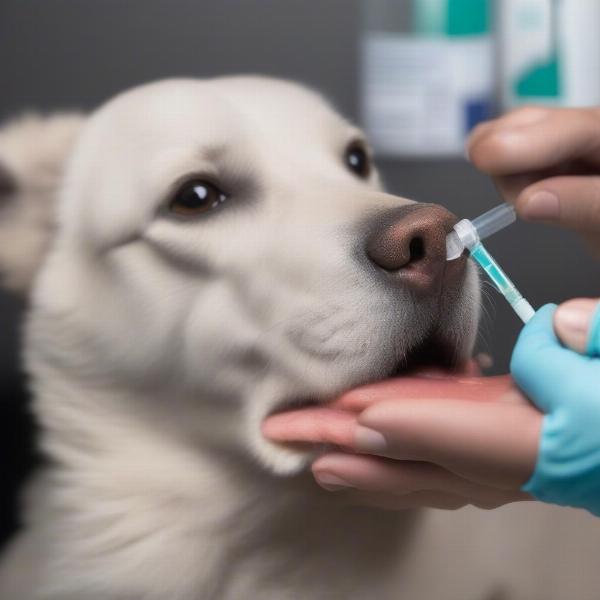Chlorhexidine dog mouthwash is a powerful tool in maintaining your dog’s oral health. It’s an antiseptic solution that helps control plaque and gingivitis, contributing to fresher breath and a healthier smile for your furry friend. This guide will delve into the benefits, usage, and precautions associated with chlorhexidine mouthwash for dogs.
Understanding Chlorhexidine for Dogs
Chlorhexidine gluconate, the active ingredient in these mouthwashes, works by disrupting bacterial cell membranes, effectively killing bacteria that contribute to plaque and gum disease. This makes it a valuable tool in both preventing and treating oral health issues in dogs. While often prescribed by veterinarians, it’s important to understand the proper usage and potential side effects.
 Applying Chlorhexidine Mouthwash to a Dog
Applying Chlorhexidine Mouthwash to a Dog
Benefits of Using Chlorhexidine Mouthwash
Using a chlorhexidine mouthwash for your dog can offer several benefits, including:
- Plaque and Tartar Control: Chlorhexidine effectively kills bacteria that form plaque, helping prevent tartar buildup.
- Gingivitis Treatment: It reduces inflammation and infection in the gums, aiding in the treatment of gingivitis.
- Fresher Breath: By reducing bacteria in the mouth, chlorhexidine mouthwash can significantly improve your dog’s breath.
- Post-Dental Procedure Care: Veterinarians often recommend chlorhexidine rinses after dental cleanings or extractions to prevent infections.
How to Use Chlorhexidine Mouthwash for Dogs
Always follow your veterinarian’s instructions for using chlorhexidine mouthwash. General guidelines include:
- Dilution: Some chlorhexidine solutions may need to be diluted with water. Your veterinarian will provide specific dilution instructions.
- Application: Use a syringe or specialized applicator to apply the mouthwash to your dog’s gums.
- Frequency: Typically, chlorhexidine mouthwash is used once or twice daily.
- Duration: The duration of treatment will depend on the specific condition being addressed.
Precautions and Side Effects
While generally safe, chlorhexidine mouthwash can have potential side effects:
- Tooth Staining: Prolonged use can cause brown staining on the teeth. This is usually cosmetic and doesn’t harm the teeth.
- Taste Alteration: Some dogs may find the taste unpleasant, leading to resistance. oral rinse for dogs can be explored.
- Irritation: In rare cases, it may cause irritation to the gums or mouth.
- Ingestion: While not typically toxic in small amounts, large ingestion can cause gastrointestinal upset.
Choosing the Right Chlorhexidine Mouthwash
Consult your veterinarian for recommendations on the most suitable chlorhexidine mouthwash for your dog. They can assess your dog’s specific needs and advise on the appropriate concentration and usage. dental rinse for dogs may be suitable for your needs.
Conclusion
Chlorhexidine dog mouthwash is a valuable tool for maintaining optimal oral hygiene in dogs. dentisept for dogs is another term used sometimes. By understanding its benefits, usage, and precautions, you can help keep your dog’s teeth and gums healthy, contributing to their overall well-being. Always consult with your veterinarian before starting any new treatment for your dog.
FAQ
- How often should I use chlorhexidine mouthwash on my dog? Follow your veterinarian’s instructions, but typically once or twice daily.
- Can chlorhexidine mouthwash stain my dog’s teeth? Yes, prolonged use can cause brown staining, which is usually cosmetic.
- What should I do if my dog swallows chlorhexidine mouthwash? Contact your veterinarian immediately. dog mouth wash is important to maintain your pet’s health.
- Is chlorhexidine mouthwash safe for all dogs? Consult your veterinarian to ensure it’s appropriate for your dog’s age, health, and specific needs.
- Can I use human chlorhexidine mouthwash on my dog? No, use only veterinary-approved products formulated for dogs. dentihex for dogs can be recommended by your vet.
- How long should I use chlorhexidine mouthwash? Follow your vet’s advice on the duration of use.
- What are the signs of gingivitis in dogs? Red, swollen gums, bad breath, and difficulty eating can be signs of gingivitis.
ILM Dog is a leading international online resource dedicated to providing expert advice on dog care and well-being. We cover everything from breed selection and health to training and nutrition, offering practical tips and insights for dog owners worldwide. Our aim is to empower you with the knowledge to make informed decisions about your dog’s care. For expert advice and personalized support, reach out to us at [email protected] or call us at +44 20-3965-8624. ILM Dog is here to help you navigate the world of dog ownership with confidence.